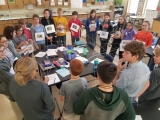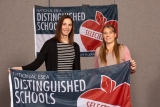-
Category 1
Selected in 2018
-
Grades: 6 - 8
School Setting: rural
Town Population: 18
Student Enrollment: 840
Student Demographics:
Black/African American: 1%
Teacher/Student Ratio: 1:23
White/Caucasian: 89%
Hispanic: 6%
Hawaiian/Pacific Islander: 1%
Asian: 1%
Native American: 1%
Other: 0%
% Reduced Lunch: 34%
% ELL Learners: 2%
Founded: 2005 -
PRINCIPAL:
Rebecca Adsit -
CONTACT:
500 Lewis Street
Sheridan, WY 82801
307-672-9745
rebecca.adsit@scsd2.com
Sheridan Junior High School
Sheridan, WY
We believe that school culture has a direct impact on student learning.
- Describe specific programs in place to ensure that families are involved in the success of your school and students.
- SJHS makes involving parents and the community a priority, utilizing our Title I Program. One way we seek to involve parents and community members is through our Parent Advisory Committee that meets once a month. During these meetings, administration and school staff present information to parents and seeks parent input and feedback. In addition, we survey parents throughout the year on a variety of topics and use their feedback to help make school-wide decisions. We offer many Title I nights at SJHS, including open house, Parent Nights, and parent/teacher conferences.
- Describe the most successful activity your school has initiated to strengthen ties to your community.
- Because of the SJHS educators’ commitment to our mission, as Dufour, Dufour, Eaker, Many, and Mattos state, “Not only must staff hold as their fundamental belief that each student has the ability to learn, but members must also organize to utilize their resources to support that singular focus “ (2016). The Professional Learning Communities (PLC) framework defines all that SJHS does and encompasses the specific strategies that have led to our school’s success in student achievement and will continue to be the platform to continue the trend that all students learn. The PLC framework provides the platform for which all work is done at SJHS. The 4 PLC questions now guide our collaboration; 1. What do we want our students to learn 2. How will we know if they have learned it 3. How will we respond when they haven't learned? 4. How will we respond when they have learned?
- What are your school’s top two goals for the next year?
- Without a doubt, SJHS's fundamental mission is to ensure ALL students learn.
- Explain how ESEA federal funds are used to support your improvement efforts.
- Sheridan Junior High School educators are committed to our mission, “The fundamental purpose of SJHS is to ensure ALL students LEARN.” The culture of our school demands learning for all. Because of this, we use our Title I funds to support this culture, knowing that the greatest factor that impacts students learning is high quality teachers, and utilize our Title I funds to train effective educators and fund two teachers (Math and English) who provide struggling students a dedicated class period to focus on students’ identified gaps in the areas of English and Math. The four essential questions of the Professional Learning Communities provide the collaborative framework that impacts student achievement because of educators’ commitment to learning and improving.
- Identify the critical professional development activities you use to improve teaching and student learning.
- The research of Linda Darling-Hammond, John Hattie, and others has revealed that teacher quality has greater impact on student learning than all other factors combined. However, research on professional development in education reveals that traditional PD approaches do not improve student learning because they are neither sustained nor embedded. With this in mind, SJHS has set out to offer professional learning that is in fact embedded, sustained, and that directly impacts teacher and administrator capacity. Our most powerful PD is systematic teacher collaboration. All SJHS teachers are members of department-specific collaborative teams. Teachers and administrators continue to grow through collaboration around focused topics such as standards, assessment, data, and intervention. Teachers participate in book studies, and new teachers participate in a three year mentoring program.
- Describe how data is used to improve student achievement and inform decision making.
- SJHS teachers rely most heavily on building-level common formative assessments to monitor student learning in content-specific collaborative groups to design essential outcomes and common assessments. Over time, our groups have refined common assessments to address specific skills and concepts, the result of which is actionable data at the individual and group level. Our assessments have also become more formative in nature as teachers have realized the power of the approach. These common assessment results are timely because teachers can respond as soon as students finish the formative assessments. Many of our teachers use technology to collect immediate data from their assessments. Teachers continue to learn each time they assess students and make ongoing adjustments to essential outcomes and their assessment instruments. The overall result, however, has been a major increase in the amount of classroom-level intervention and a subsequent increase in student mastery.
- Describe your school culture and explain changes you’ve taken to improve it.
- We believe that school culture has a direct impact on student learning. SJHS adopted the Positive Behavior Interventions & Supports (PBIS) philosophy in 2007 and continues to follow this model as it applies to teaching expectations/procedures, building in supports/interventions, and analyzing behavior data. To maintain a positive culture, we also take student activities very seriously. Including athletic and non-athletic activities, there are 18 separate activities in which students may participate. Historically, over 80% of our students choose to join a team, club, or activity each year. The hard work of staff and students allows SJHS to continue great progress and make the move from good to great. Our Title I teachers meet with PLC teams as well as individual teachers on a biweekly basis to collaborate around individual students’ needs. The overall result has been a major increase in the amount of classroom-level intervention and a subsequent increase in student mastery.
Stats
-
Category 1
Selected in 2018
-
Grades: 6 - 8
School Setting: rural
Town Population: 18
Student Enrollment: 840
Student Demographics:
Black/African American: 1%
Teacher/Student Ratio: 1:23
White/Caucasian: 89%
Hispanic: 6%
Hawaiian/Pacific Islander: 1%
Asian: 1%
Native American: 1%
Other: 0%
% Reduced Lunch: 34%
% ELL Learners: 2%
Founded: 2005 -
PRINCIPAL:
Rebecca Adsit -
CONTACT:
500 Lewis Street
Sheridan, WY 82801
307-672-9745
rebecca.adsit@scsd2.com






